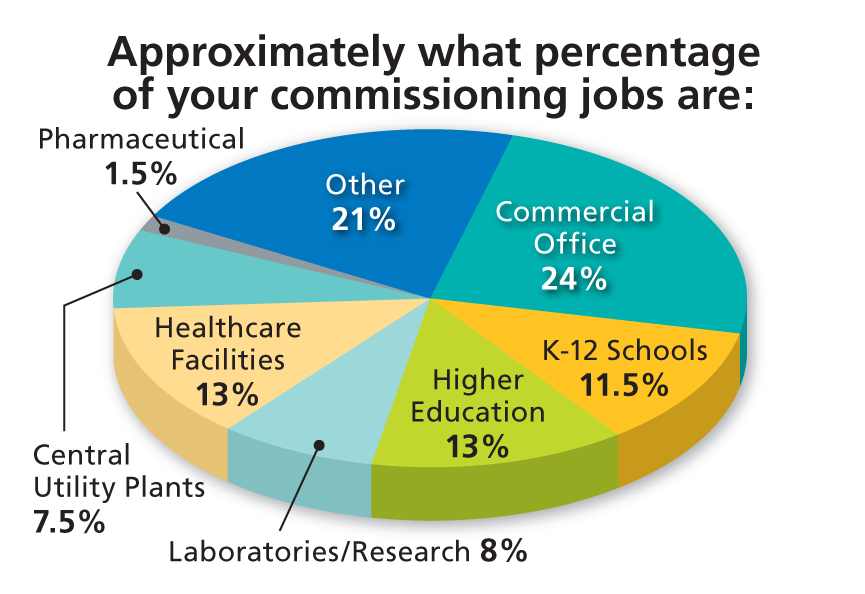Despite challenges both new and old, and an economy that is improved but still not roaring, commissioning firms remain hopeful about the upcoming year.

Does 2013 looks just like 2012? Maybe. But while the numbers for the commissioning (Cx) market seem to indicate a somewhat idle industry, respondents to an exclusive survey reveal a more positive outlook. There is a hint of business “picking up”—that a lack of significant growth from 2012 is neither a surprise nor a letdown, but instead reflects an economy still finding its new legs.
There was an overall increase in Cx business among firms surveyed. Almost half (47%) report that commissioning comprises 20% or less of their business, whereas in 2012, that number was 50%. Moreover, firms reporting commissioning to be 85% or more of their business increased, from 22% last year to just less than 30% this year. The trend was reflected in respondent commentary, where half of the remarks indicated that either all or at least certain segments of commissioning were on the rise.
The optimism regarding the increase in work was great news. Unfortunately, the ideal commissioning situation, wherein the Cx provider is an experienced and independent third-party provider hired directly by the owner and engaged during a project’s earliest stages, continues to be more the exception than the rule.
More than 40% of firms said that they are hired as an independent third-party 85% to 100% of the time, and this has remained a constant since 2011. Similarly, a little more than half of this year’s respondents indicated that they are hired directly by the owner or the architect.
Regarding one of the key concerns of Cx providers—at the point they’re brought onto a project— the numbers appear to be about the same as last year’s. As with last year, 42% of the time, respondents report that they aren’t brought on until the construction phase. However, that number was 46% in 2011. Has a slow trend toward earlier participation begun? Seeing how firms respond to this question in 2014 will be interesting.
New this year, ACG asked those who have been retained in the early stages of a project what factors or strategies they thought helped them to gain early job involvement. By far, three factors stood out:
- The level of education or awareness building owners have of the benefits of early commissioning engagement
- U.S. Green Building Council LEED or various code requirements mandating early participation of Cx providers
- A Cx firm’s reputation, experience, and established relationships.
Building types, sectors, and Cx scope
Many in the industry have predicted a shift in focus toward existing building commissioning. Statistically, this year showed no additional push in that direction, with 74% of firms’ commissioning business still coming from new construction. However, in response to an open-ended question about trends, many respondents reported that they still anticipate this direction in the future.
When their firms did perform existing building Cx, ACG asked what their clients’ motivations were. The highest priority reported was energy cost reduction. But right behind that, the No. 2 reason was building performance. As one respondent put it, “Reliable building system performance outweighs other owner issues. The main cause of inefficient operation is frequently improper system operation.”
Providers still see roughly the same mix of facility types, with commercial office buildings being the most common, at nearly a quarter of the total. Higher education dropped off by a few percentage points, whereas central utility plants gained a few.
The private sector still provides the largest percentage of Cx work, accounting for 39%—the same as 2012—but is another example of a jump from 2011 (33%) to 2012, only to level out this year. All other sectors in the survey stayed the same, with the exception of federal, non-military jobs, which decreased from 11% to 8%, a trend also noted in the comments of many respondents’ who indicated a general decrease in government work.
HVAC, domestic hot water, and lighting/lighting controls remain the most frequently commissioned systems. This comes as no surprise since those are the three systems currently required at minimum to meet the LEED commissioning prerequisite.
Other building systems commissioned showed the same or a slight decrease in frequency, including building envelope, from 15% in 2012 to 12% this year. And while respondent comments didn’t explain this dip, they didn’t seem all that phased by it either, anticipating a growth nonetheless in building envelope commissioning.
One decrease of note was the number of Cx providers who partner with other firms to commission various systems outside the scope of their firm’s expertise. While that number had jumped substantially in 2012 to 71% from 55% in 2011, it plunged this year, with only 47% of respondents subcontracting to other firms. Whether this is a trend or a short-term strategy by Cx firms to bring more types of services in-house to combat the impediments of a still recovering economy, only time will tell. This is another area to keep an eye on in 2014.
Energy management services
Energy management work continues to be incorporated in Cx firms’ suite of services. The number of firms that provide these services, separate from traditional commissioning, dropped slightly from 80% last year to 75% in 2013. However, this simply could be due to the fact that, as some respondents mentioned, their firms are now combining energy-related work with commissioning. In other words, perhaps less of a distinction is being made as energy management services become more and more common. (ACG’s energy management initiative, in fact, is built in significant part on the idea that comprehensive energy management services are best delivered within a commissioning-based framework.)
Moreover, more companies reported that they performed more types of energy management services. For example, energy audits, energy savings calculations, energy modeling, and measurement and verification all saw increases from last year.
There was good news among respondents concerning how often their firm was involved in implementing recommended energy conservation measures. Those who were involved 20% of the time or less dropped from 72% to 61%, while those who saw their firm’s involvement roughly half of the time increased by 10%, from 12% to 22%. And even though only 5% of firms were involved in implementing recommended measures 65% to 100% of the time, that number represented a slight increase from 2012.
In general, of the respondents who addressed whether energy management work would increase in 2014, a little over half thought it would. Most of the other half predicted it would remain the same, and only a small percentage (5%) thought they would see a decrease in energy-related work.
Cx and LEED
The U.S. Green Building Council’s LEED rating system remains a key driver of commissioning work due to its “fundamental commissioning” requirement, a prerequisite to obtaining a LEED-certified building designation, as well as the optional credit it offers for “enhanced commissioning.” The industry is currently awaiting LEED version 4, which is slated to be released in fall 2013 and is expected to include important changes to the commissioning requirements.
LEED-driven jobs rose again this year, with 70% of respondents indicating that most (65% to 100%) of their firm’s recent Cx jobs involved LEED projects, a 12% increase over last year’s 58%.
Another 12% increase was seen in the amount of LEED projects pursuing the enhanced commissioning credit, with 52% of responding firms citing 65% or more of their LEED projects pursuing the credit and 23% citing that 85% to 100% of their firm’s LEED projects were doing so. Considering that those numbers were 28% and 15%, respectively, in 2011, it is safe to say that the enhanced commissioning credit continues to plays a major role in LEED-related Cx work.
Challenges and trends
Regarding the top commissioning-related challenges firms face, five themes have clearly emerged over the past three years. Although the five categories might switch places year to year, they remain the most common struggles in the industry:
5. Finding qualified personnel. Finding, hiring, training, or retaining qualified personnel remains an issue, though not as prevalent as last year, and one much less emphasized than the other four.
4. Obtaining work. While obtaining work made the top five again, it decreased slightly from last year. Economic factors contributing to this difficulty remain the same among commissioning providers: an economy still in recovery and slow to generate new construction, and a decline in federal and other public projects.
3. Understanding of Cx value, late engagement. These issues are grouped together here as they seem to have a cause-and-effect relationship. As noted above in the article, even though commissioning providers continue to extol the benefits of early involvement in a project, and despite mandates in building rating systems that require it, predesign participation remains infrequent. Could this be the result of another top challenge cited by survey respondents, that many building owners still don’t understand the value of comprehensive commissioning? The two seem inexorably connected.
2. Competition, pricing, and condensed Cx scopes. These interrelated issues—often noted as such by respondents—continue to present challenges to Cx providers, though they fell from the No. 1 spot held last year. Of particular concern to respondents was the abundance of firms offering “commissioning lite,” which in turn creates a downward pressure on fees. Providers are still too often faced with the choice of doing a limited scope on a given project or not getting the job at all.
1. Scheduling. Coming in strong as the No. 1 challenge this year was what was described in 2011 as the problem of “herding cats.” In other words, getting the various players on the commissioning team on the same page, so that project schedules remain on track, continues to be a hitch. Respondents cited several examples of issues impacting the project schedule, including getting documentation on time and correctly filled out and the old agitator, being told systems are ready for testing when they’re not.
Finally, respondents were again asked to share their thoughts about possible upcoming trends in commissioning. The majority indicated that they anticipated the same three trends that topped the 2012s ACG survey: an increase in retro- or existing building Cx projects, more demand for building envelope Cx, and a decline in projects focused on LEED certification.
Methodology
For the third year, the nonprofit AABC Commissioning Group (ACG) conducted a survey of nearly 500 companies that provide commissioning services to learn about their biggest concerns and obstacles, what kind of work they are doing now, and what they expect to be doing in the coming year. With nearly 160 firms responding (32% response rate), ACG has a good idea about what has changed since the survey was first conducted in 2011, and in what direction commissioning firms are expecting the industry to go. As with previous years, all of the companies surveyed are professional, independent firms that are not engaged in contracting or manufacturing work.
ACG collects new data
This year, a few new questions were added to provide a broader perspective on what is impacting the industry and where firms saw it heading. Is the trend toward codifying commissioning a concern? Are any new technologies proving useful? And finally, are firms reaching beyond the American borders to procure work?
Codes: When asked for comments or concerns regarding commissioning being incorporated into building codes, ACG got a variety of answers. On the positive side, respondents felt that such regulation might ensure consistency within the industry, help raise the bar for commissioning services, and create business. Others responded that they felt code-mandated commissioning would be a welcome development as long as they mandated that Cx providers be certified, independent, third-party entities.
However, just as many respondents were concerned that the collision of codes and commissioning would serve only to commodify the industry, enabling less qualified competition to flood the market. Some respondents felt that in their current form, codes that address commissioning lack clear definitions and are too open to interpretation, especially by authorities having jurisdiction (AHJs), and therefore unenforceable.
New technologies: In a world where new technologies seem to arrive on the scene daily, we wondered which ones commissioning agents (CxAs) were finding useful. Many mentioned that portable electronics such as tablets, iPads, and smartphones were facilitating Cx work. Online software such as cloud-based systems were said to be helpful. Wireless technologies, both in terms of access to controls and monitoring, made the list as well. And finally, some respondents said that recently improved data loggers were proving helpful tools.
New markets: Since the general outlook on the market in the United States was rather pessimistic in 2012, the survey asked if anyone was looking abroad for more commissioning opportunities. The responses indicated a resounding “yes.” Separated into regions, many respondents reported that they had worked, were currently working, or planned to work in the Middle East. Following closely was Latin America. Asia and Europe were also frequently mentioned. A few respondents listed Africa, and some firms indicated that they work worldwide. Clearly, there are opportunities all over the world for commissioning work.
Ray Bert is executive director and Amanda Thomason is director of communications at the AABC Commissioning Group (ACG).



